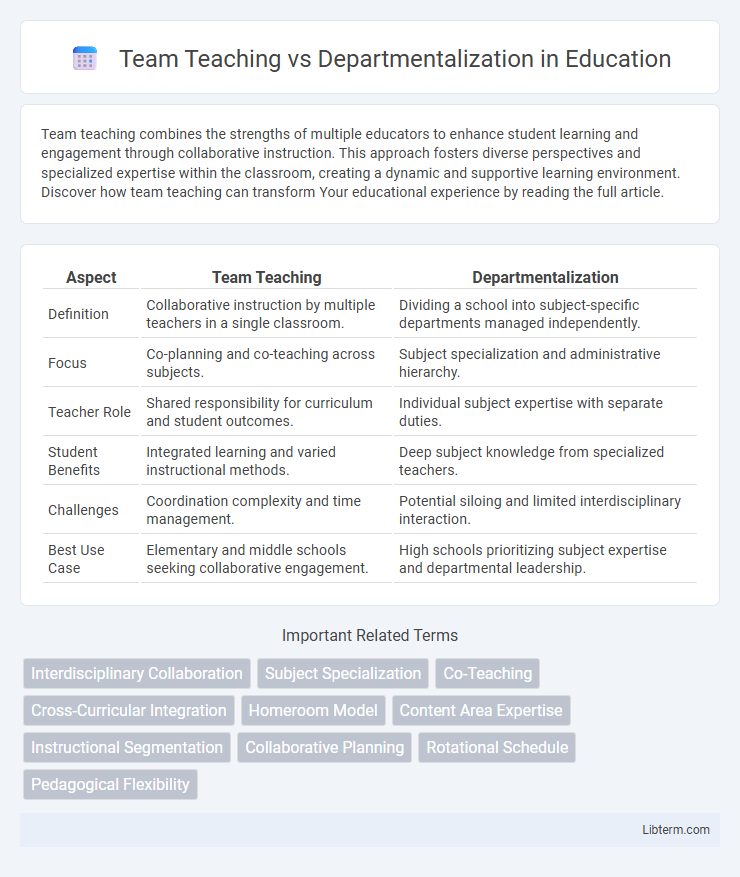Team teaching combines the strengths of multiple educators to enhance student learning and engagement through collaborative instruction. This approach fosters diverse perspectives and specialized expertise within the classroom, creating a dynamic and supportive learning environment. Discover how team teaching can transform Your educational experience by reading the full article.
Table of Comparison
| Aspect | Team Teaching | Departmentalization |
|---|---|---|
| Definition | Collaborative instruction by multiple teachers in a single classroom. | Dividing a school into subject-specific departments managed independently. |
| Focus | Co-planning and co-teaching across subjects. | Subject specialization and administrative hierarchy. |
| Teacher Role | Shared responsibility for curriculum and student outcomes. | Individual subject expertise with separate duties. |
| Student Benefits | Integrated learning and varied instructional methods. | Deep subject knowledge from specialized teachers. |
| Challenges | Coordination complexity and time management. | Potential siloing and limited interdisciplinary interaction. |
| Best Use Case | Elementary and middle schools seeking collaborative engagement. | High schools prioritizing subject expertise and departmental leadership. |
Introduction to Team Teaching and Departmentalization
Team teaching involves multiple educators collaboratively planning, instructing, and assessing students within a shared classroom environment, promoting diverse expertise and interactive learning. Departmentalization segregates instruction by subject areas, with teachers specializing in specific disciplines, enhancing content depth and instructional efficiency. Both approaches aim to optimize educational outcomes through distinct organizational structures tailored to student needs and institutional goals.
Defining Team Teaching: Key Concepts
Team teaching involves multiple educators collaboratively delivering instruction to the same group of students, enhancing learning through shared expertise and diverse teaching styles. Key concepts include co-planning, co-instruction, and continuous communication to ensure cohesive lesson delivery and responsive classroom management. This approach contrasts with departmentalization, where teachers specialize in specific subject areas and work independently within their disciplines.
Understanding Departmentalization in Education
Departmentalization in education organizes instruction by subject areas, enabling teachers to specialize and enhance content mastery, which improves student outcomes in complex subjects like math and science. This structure facilitates resource allocation and scheduling efficiency within schools, promoting consistency and depth of curriculum delivery. In contrast to team teaching, which emphasizes collaborative instruction across subjects, departmentalization fosters expertise and focused assessment for each discipline.
Historical Perspectives and Trends
Team teaching emerged in the mid-20th century as an innovative educational approach promoting collaborative instruction and integrated curricula, contrasting with the traditional departmentalization model that dates back to the 19th century emphasizing subject-specific expertise and hierarchical structures. Historical trends show increasing interest in team teaching during the 1970s and 1980s as educators sought interdisciplinary learning environments, while departmentalization maintained dominance in many institutions due to its clear specialization and administrative efficiency. Recent shifts highlight a blended approach where schools incorporate team teaching strategies within departmental frameworks to balance collaborative learning with subject matter depth.
Advantages of Team Teaching
Team teaching enhances student engagement by combining diverse pedagogical skills and subject expertise, fostering a richer learning environment. It promotes collaborative planning and continuous professional development among teachers, leading to improved instructional strategies. Increased individualized attention and varied perspectives within team teaching support differentiated learning and better address students' unique needs.
Benefits of Departmentalized Instruction
Departmentalized instruction allows teachers to specialize in specific subject areas, enhancing expertise and improving instructional quality. This system promotes consistency in curriculum delivery and assessment across grade levels, streamlining student learning experiences. By grouping students based on subject, departmentalization effectively addresses diverse learning needs through targeted teaching strategies.
Challenges and Limitations of Team Teaching
Team teaching faces challenges such as coordinating schedules and aligning instructional methods among educators, which can lead to inconsistencies in student learning experiences. It demands high levels of communication and collaboration, potentially resulting in increased workload and conflicts if roles and responsibilities are not clearly defined. Resource allocation and assessment standardization also pose limitations, making it difficult to evaluate individual teacher performance and student progress effectively.
Drawbacks of Departmentalization
Departmentalization often leads to communication barriers between specialized units, causing delays in decision-making and reduced collaboration. It can create silos where employees prioritize departmental goals over organizational objectives, resulting in inefficiencies and internal conflicts. The rigid structure limits flexibility and adaptability, hindering innovation and rapid response to market changes.
Choosing the Right Approach for Your School
Selecting between team teaching and departmentalization depends on your school's size, curriculum complexity, and collaboration goals. Team teaching fosters interdisciplinary learning and personalized instruction by enabling multiple educators to co-manage a classroom, which enhances student engagement and support. Departmentalization offers subject-specific expertise and streamlined content delivery, making it ideal for schools with diverse academic programs and larger student populations.
Future Directions in Collaborative and Specialized Teaching
Future directions in collaborative and specialized teaching emphasize integrating team teaching with departmentalization to enhance interdisciplinary learning and subject expertise. Advanced technologies enable seamless coordination among teachers, promoting dynamic lesson delivery and personalized student support. Embracing hybrid models that combine collaboration and specialization drives innovation in pedagogy and improves educational outcomes.
Team Teaching Infographic

 libterm.com
libterm.com